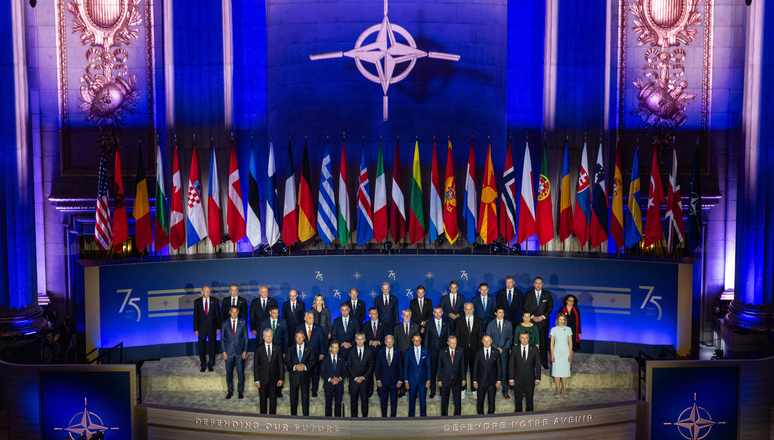Understanding NATO
This training module is designed to help our student competitors be more familiar with NATO's foundation, mission, and activities. With this increased knowledge, our students teams will create stronger and more feasible solutions to the problem of countering disinformation. Portions of this come from www.nato.int.
About NATO
NATO is a political and military alliance created to ensure the collective defense of its members. It was founded in 1949 with the signing of the North Atlantic Treaty or Washington Treaty. At its founding, NATO had three primary purposes: deter Soviet expansionism, forbid the revival of nationalist militarism in Europe through a strong North American presence on the continent, and encourage European political integration. Today, these can be characterized as deterrence and defense, crisis prevention and management, and cooperative security.
The NATO Treaty derives its authority from Article 51 of the United Nations Charter, which reaffirms the inherent right of independent states to individual or collective defence. It is only 14 articles long, one of the shortest in international documents. At the core of NATO's defense is Article 5, which declares that an attack on one is an attack on all. Article 5 has been invoked only once in NATO's history following the September 11, 2001 attacks on the United States. Over time, NATO has adapted to modern threats like disinformation and cyber-attacks, maintaining its key role in global security and fostering international cooperation through defense and crisis management.
Did you know? The original Treaty has never had to be modified! Each Ally implements its text with their own capabilities and circumstances. NATO is flexible!
Visit NATO's About Us Webpage to learn more.
Click on the Video Resources below to learn more about NATO
The History and Mission of NATO (W&M Video)
Click here to read about NATO Allied Command Transformation
NATO's Strategic Priorities
Since its founding, NATO's strategic priorities are oriented toward enhancing the collective defense of its Member Nations and Partners. The current Strategic Concept (2022) reaffirms that NATO’s key purpose is to ensure the collective defence of its members, based on a 360-degree approach. This document addresses what NATO sees as its strategic environment: pervasive instability and recurrent shocks; Russian aggression; terrorism; conflict and instability in the Middle East and Africa; pervasive instability and its impact on civilians, cultural property and the environment; China’s stated ambitions and coercive policies; cyberspace; emerging and disruptive technologies; the erosion of arms control, disarmament and non-proliferation architectures; and the security implications of climate change. Visit "What We Do" to learn more.
In our competition today, we focus on one of NATO's strategic priorities, countering disinformation. NATO has a number of resources and documents addressing the threat of mis- and disinformation.
- "NATO's Approach to Countering Disinformation"
- "Communications and Public Diplomacy"
- "Tips to Spot and Counter Disinformation"
- "Setting the Record Straight: De-bunking Russian disinformation on NATO"
- "How Does NATO Respond to Disinformation?"
Highlights from NATO's History
- 1949: NATO is established with 12 founding members.
- 1950-1953: During the Korean War, NATO begins building its military structure in response to the global threat of communism.
-
1955: West Germany joins NATO. In response, the Soviet Union and its Communist satellite states create the Warsaw Pact.
-
1961: Construction on the Berlin wall begins, preventing citizens of East Germany from traveling to the West for over 28 years.
-
1967: The new NATO Headquarters opens in Brussels, Belgium.
- 1970: A victory for détente! The Nuclear non-Proliferation Treaty is ratified by the United Kingdom, United States, and the Soviet Union.
- 1974: The Declaration on Transatlantic Relations expands NATO's concept of security to include economic concerns.
-
1989: The Berlin Wall falls, signaling the end of the Cold War.
- 1994: NATO launches its Partnership for Peace Programme, strengthening bilateral cooperation and relations with Central and Eastern European nations. NATO engages in its first combat operations in the Bosnian War.
- 1995: NATO launches its first peacekeeping mission, deploying the Implementation Force (IFOR) following the Dayton Peace Accords that ended the Bosnia and Herzegovina conflict.
- 1997: The Charter on a Distinctive Partnership is signed by NATO and Ukraine to advance relations and enhance engagements.
-
2001: Article 5 is invoked for the first time following the September 11, 2001 attacks on the United States.
- 2003: NATO takes command of the International Security Assistance Force (ISAF) in Afghanistan.
-
2022: NATO adopts its updated Strategic Concept, focusing on modern threats like cyber warfare. Russia invades Ukraine, prompting NATO leaders to condemn the invasion, activate defense plans, and deploy thousands of additional troops and resources to its eastern flank.
- 2024: With the inclusion of Sweden, NATO now has 32 members.
Visit here for more on NATO's history.
Current NATO Countries
 |
||
| Albania (2009) | Belgium (1949) | Bulgaria (2004) |
| Canada (1949) | Croatia (2009) | Czechia (1999) |
| Denmark (1949) | Estonia (2004) | Finland (2023) |
| France (1949) | Germany (1955) | Greece (1952) |
| Hungary (1999) | Iceland (1949) | Italy (1949) |
| Latvia (2004) | Lithuania (2004) | Luxembourg (1949) |
| Montenegro (2017) | Netherlands (1949) | North Macedonia (2020) |
| Norway (1949) | Poland (1999) | Portugal (1949) |
| Romania (2004) | Slovakia (2004) | Slovenia (2004) |
| Spain (1982) | Sweden (2024) | Turkiye (1952) |
| United Kingdom (1949) | United States (1949) | |
What does NATO mean to Us?
Hear from the WMGIC students as they share their quick, personal takes on what NATO means to them. You do not want to miss their unique insights!
Click here to listen to what NATO means to us!
Complete Your NATO Learning Journey!
This short exit quiz will test your knowledge of NATO's key concepts. It is a quick and easy way to verify that you have grasped the main points and to reflect on what you have learned. Click the link below to complete the exit ticket!














